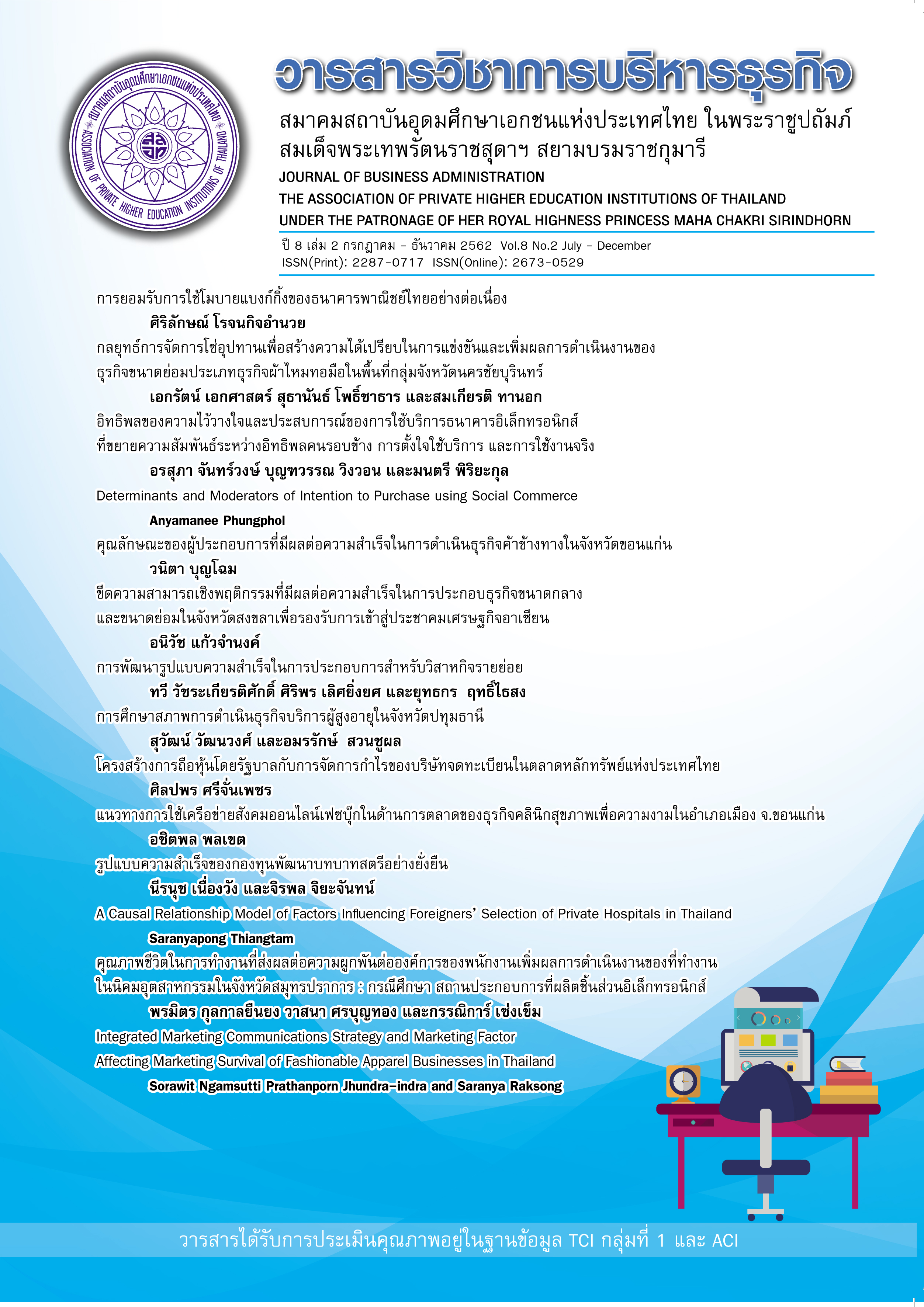โมเดลความสัมพันธ์เชิงสาเหตุของปัจจัยที่มีอิทธิพลต่อการเลือกโรงพยาบาล เอกชนในประเทศไทยของชาวต่างชาติ
คำสำคัญ:
คุณภาพบริการ, การตลาด, นวัตกรรม, ความพึงพอใจ, โรงพยาบาลเอกชนบทคัดย่อ
การศึกษานี้มุ่งพัฒนาและตรวจสอบโมเดลความสัมพันธ์เชิงสาเหตุของปัจจัยที่มีอิทธิพลต่อการเลือก
โรงพยาบาลเอกชนในประเทศไทยของชาวต่างชาติ กลุ่มตัวอย่างคือลูกค้าชาวต่างชาติของโรงพยาบาลเอกชนใน
ประเทศไทยที่ได้จากการเลือกแบบสะดวก ผู้วิจัยใช้แบบสอบถามแบบมีโครงสร้างเป็นเครื่องมือในการรวบรวมข้อมูล
และใช้โมเดลสมการโครงสร้างในการวิเคราะห์ ผลการวิจัยชี้ว่าโมเดลสมมติฐานที่พัฒนาขึ้นมีความสอดคล้องกับข้อมูล
เชิงประจักษ์ ค่าสถิติที่แสดงความสมรูปดีได้แก่ ค่าไคสแควร์เท่ากับ 2.16 ค่าองศาอิสระเท่ากับ 2 ค่าพี (p) เท่ากับ
.34 ค่าไคสแควร์สัมพัทธ์เท่ากับ 1.08 ค่าดัชนีความสอดคล้อง GFI เท่ากับ .99, CFI เท่ากับ 1.000 และค่ารากที่สอง
ของความคาดเคลื่อนของการประมาณค่า เท่ากับ .01 โดยตัวแปรภายนอกได้แก่ การรับรู้คุณภาพคลินิก คุณภาพ
บริการ การตลาด ความมีนวัตกรรม/นวัตกรรมของโรงพยาบาล และตัวแปรภายในได้แก่ความพึงพอใจอธิบาย
ความแปรปรวนของการเลือกโรงพยาบาลเอกชนในประเทศไทยของชาวต่างชาติได้ร้อยละ 65.40
เอกสารอ้างอิง
Al-Qarni, A. A., Alsharqi, O. Z., Qalai, D. A., & Kadi, N. (2013). The impact of marketing mix strategy on hospitals performance measured by patient satisfaction: an empirical investigation on Jeddah private sector hospital senior manager perspective. International Journal of Marketing Studies, 5(6), 210.
Anderson, E. W., & Sullivan, M. W. (1993). The antecedents and consequences of customer satisfaction for firms. Marketing Science, 12(2), 125-143.
Anderson, E. W., Fornell, C., & Lehmann, D. R. (1994). Customer satisfaction, market share, and profitability: Findings from Sweden. The Journal of Marketing, 58(3), 53-66.
Chen, C.-F., 2008. Investigating structural relationships between service quality, perceived value, satisfaction, and behavioral intentions for air passengers: evidence from Taiwan. Transport. Res. Part A 42(4), 709–717.
Choi, K. S., Cho, W. H., Lee, S., Lee, H., & Kim, C. (2004). The relationships among quality, value, satisfaction and behavioral intention in health care provider choice: A South Korean study. Journal of Business Research, 57(8), 913-921.
Cronin, J. J., & Taylor, S. A. (1992). Measuring service quality: a reexamination and extension. The Journal of Marketing, 56(3), 55-68.
Cronin, J. J., Brady, M. K., & Hult, G. T. M. (2000). Assessing the effects of quality, value, and customer satisfaction on consumer behavioral intentions in service environments. Journal of retailing,76(2), 193-218.
Greve, G. (2014). The moderating effect of customer engagement on the brand image-brand loyalty relationship. Procedia – Social and Behavioral Sciences, 148, 203-210.
Grönroos, C. (1984). A service quality model and its marketing implications. European Journal of Marketing, 18(4), 36-44.
Hair, J.F., Anderson, R.E., Tatham, R.L., & Black, W.C. (2006). Multivariate Data Analysis (6thed). New Jersey: Prentice Hall,
Hair, J. F., Sarstedt, M., Ringle, C. M., & Mena, J. A. (2012). An assessment of the use of partial least squares structural equation modeling in marketing research. Journal of the Academy of Marketing Science, 40(3), 414-433.
Harryono, M., Huang, Y. F., Miyazawa, K., & Sethaput, V. (2006). Thailand medical tourism cluster. Retrived from http://www.deik.org.tr › contents-fileaction-14405.
Health Service Support Department, Ministry of Public Health. (2012). Documentation of the 4Th Academic Conference for Senior Executives from 6 organization on July 5, 2013. Retrieved from http://www. ect.go.th/forum/forum003.pdf
Hult, G. T. M., Hurley, R. F., & Knight, G. A. (2004). Innovativeness: Its antecedents and impact on business performance. Industrial marketing management, 33(5), 429-438.
Johne, A., & Davies, R. (2000). Innovation in medium-sized insurance companies: how marketing adds value. International Journal of Bank Marketing, 18(1), 6-14.
Kim, K. H., Kim, K. S., Kim, D. Y., Kim, J. H., & Kang, S. H. (2008). Brand Equity In Hospital Marketing. Journal of Business Research, 1(61), 75-82.
Liu, C. Y., Feng, X. L., & Shang, S. M. (2017). Determinants of patient loyalty to healthcare providers: An integrative review. International Journal for Quality in Health Care, 29(4), 442-449.
Luo, X., & Homburg, C. (2007). Neglected Outcomes of Customer Satisfaction. Journal of Marketing, 71(2), 133-149. http://dx.doi.org/10.1509/jmkg.71.2.133
McQuitty, S., Finn, A., & Wiley, J. B. (2000). Systematically Varying Customer Satisfaction and its Implications for Product Choice. Academy of Marketing Science Review, Retrieved from http://www.amsreview.org/articles/mcquitty10-2000.pdf
Naidu, A. (2009). Factors affecting patient satisfaction and healthcare quality. International journal of health care quality assurance, 22(4), 366-381.
NaRanong, A., & NaRanong, V. (2011). The effects of medical tourism: Thailand's experience. Bulletin of the World Health Organization, 89(5), 336-344.
National Statistical Office, Ministry of Information and Communication Technology. (2017). The Private Hospital Survey. http://service.nso.go.th/nso/web/survey/surpop2-46.html
Oliver, R. L. (1993). A conceptual model of service quality and service satisfaction: compatible goals, different concepts. Advances in Service Marketing and Management, 2 , 65-85.
Parasuraman, A., Zeithaml, V. A., & Berry, L. L. (1988). Servqual. Journal of retailing, 64(1), 12-40.
Rerkrujipimol, J., & Assenov, I. (2011). Marketing strategies for promoting medical tourism in Thailand. J Tour Hosp Cul Arts, 3(2), 95-105.
Stock, R. M. (2011). How does product program innovativeness affect customer satisfaction? A comparison of goods and services. Journal of the Academy of Marketing Science, 39(6),813-827.
Taylor, S. A., & Baker, T. L. (1994). An assessment of the relationship between service quality and customer satisfaction in the formation of consumers' purchase intentions. Journal of retailing,70(2), 163-178.
Thiangtam, S., Anuntavoranich, P., & Puriwat, W. (2016). Impact of perceived company's innovativeness, service quality and customer satisfaction on repurchase of life insurance. Pertanika Journal of Social Sciences & Humanities, 24(3) , 145-154.
Wongkit, M. M., & McKercher, B. (2013). Toward a typology of medical tourists: A case study of Thailand. Tourism Management, 38, 4-12.
Wu, C. C. (2011). The impact of hospital brand image on service quality, patient satisfaction and loyalty. African Journal of Business Management, 5(12), 4873-4882.

ดาวน์โหลด
เผยแพร่แล้ว
รูปแบบการอ้างอิง
ฉบับ
ประเภทบทความ
สัญญาอนุญาต
บทความที่ลงตีพิมพ์ในวารสารวิชาการบริหารธุรกิจ สมาคมสถาบันอุดมศึกษาเอกชนแห่งประเทศไทยต้องเป็นบทความที่ไม่เคยได้รับการตีพิมพ์เผยแพร่ หรืออยู่ระหว่างการพิจารณาตีพิมพ์ในวารสารอื่นๆ การละเมิดลิขสิทธิ์เป็นความรับผิดชอบของผู้ส่งบทความโดยตรง

